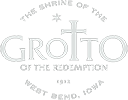About the Artist
Father Paul Matthias Dobberstein was born in Rosenfeld, Germany on September 21, 1872. He received part of his early education at the University of Deitsche-Krone in Germany. When Paul was 20 years old he immigrated to America. On coming to America he entered the Seminary of St. Francis near Milwaukee to prepare for the Priesthood. It was there that he began to show signs of unusual artistic ability that was to characterize all the waking hours of his earthly existence. He completed his studies for the Priesthood at St. Francis Seminary and was ordained there on June 30th, 1897.
For one year he served as chaplain for the Sisters of Mount Carmel hospital in Dubuque. Then when the Archdiocese of Dubuque was divided and Sioux City jurisdiction was formed he was appointed the pastor of West Bend Sts. Peter and Paul Catholic Church and remained there in that capacity for the rest of his life. During fifty-seven years he was counselor, instructor, and leader to the parishioners of St. Peter and Paul’s.
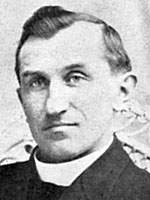
Origin and Inspiration
The story of how the Grotto came into being is as moving as are the scenes it portrays. It is generally told as a fact that as a young seminarian, Father Dobberstein became critically ill with pneumonia. As he fought for his life he prayed to the Blessed Virgin Mary (the Mother of God) to intercede for him for the grace of health. He promised to build a shrine in her honor of he lived. The illness passed, the student completed his studies and after his ordination, he came to West Bend as Pastor in 1898. For over a decade he was stockpiling rocks and precious stones.
The actual work of giving permanence to his promise began to take shape in 1912. The designed purpose of the Grotto is to tell in silent stone made spiritually eloquent, the story of man’s fall and his redemption by Christ, the savior of the world.
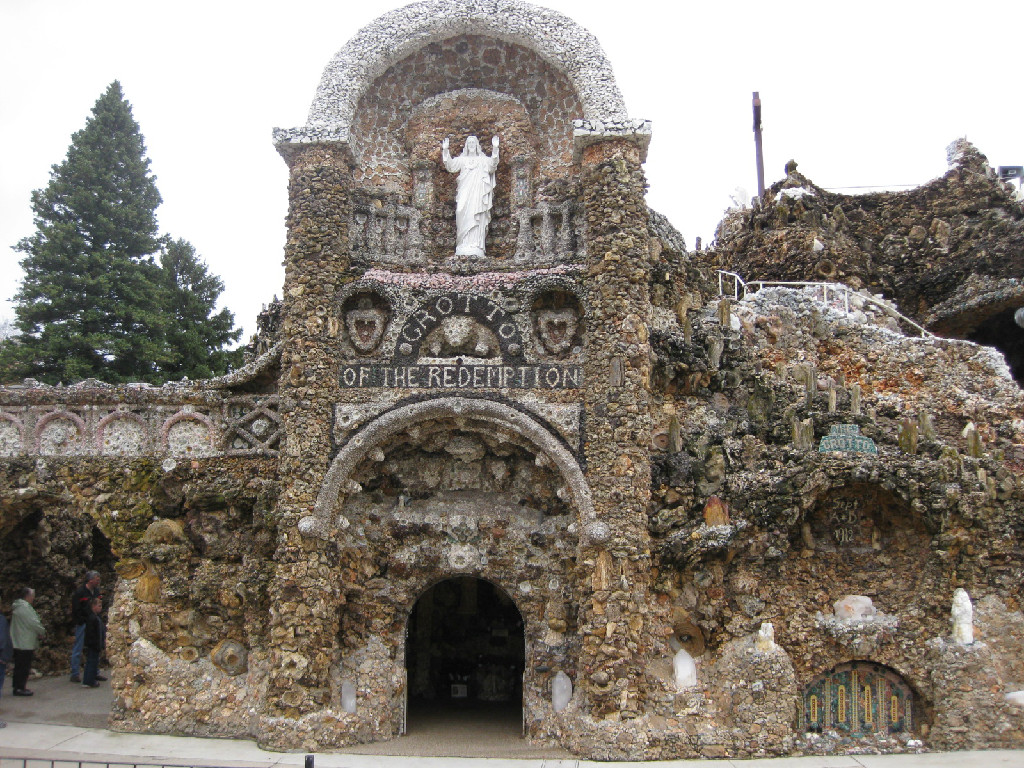
Setting
West Bend is located in the center of a vast, lush, level expanse of Iowa farmland. Wise, industrious and fairly prosperous farmers populate the surrounding area. It is located northwest of Fort Dodge about midway between the busy state highways: number 18 to the north and number 20 to the south. On most road maps, West Bend is marked as the site of the Grotto of the Redemption. It might seem odd that here where scarcely any type of rock is known, not to mention any deposits of precious geological specimens, that this collection of unique stone should be found. However, it is merely the play of divine providence that determined the setting in this particular place. This site was chosen because the Bishop decided to send Father Dobberstein to that particular parish, located in West Bend, Iowa.
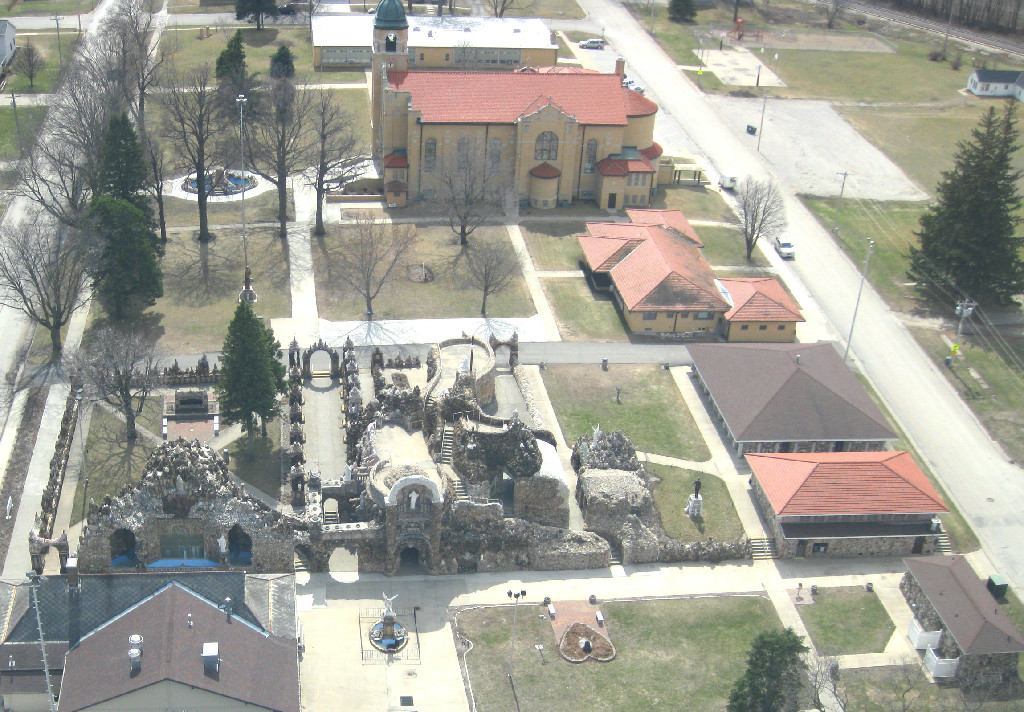
Materials
The love of precious stones is deeply implanted in the human heart, and the cause of this must be sought not only in their coloring and brilliancy but also in their durability. All the fall colors of flowers and foliage, even the blue of the sky and glory of the sunset clouds, only last for a short time and are subject to continual changes, but the sheen and color of precious stones are the same today as they were thousands of years ago and will be for countless years to come. In a world of change, this permanence has a charm of its own that was appreciated early in the history of mankind and remains to this day.
It is evident from his work that Father Dobberstein was a great lover of beauty. In fulfilling his vow to erect a shrine to the Mother of Christ he was determined to make the most of material beauty and to emphasize the spiritual beauty of the woman he had in mind. We can imagine with what love his heartbeat when he found a pearl, warm glowing rubies, and celestial hued sapphires to incorporate into the shrine. It was a source of great pleasure to him to gather them here that all might see and admire what he had done. It was his purpose that others might see in the beauty of stones the beauty of the Creator and by being charmed and attracted by his work learn to imitate the virtues of the Mother of our Saviour.
Father Dobberstein used a vast collection of minerals and precious and semi-precious stones in the building of the Grotto. Petrified wood, malachite, azurite, agates, geodes, jasper, quartz, topaz, calcite, stalactites, and stalagmites are but a partial list of rocks gathered, purchased or donated for the building of the Grotto. The many offerings of visitors have aided substantially to create this artistic wonder.
Learn More: Geology

Labor
Most architects and contractors would hesitate a long time before undertaking a project such as the Grotto of the Redemption in West Bend. It is doubtful whether it can or ever will be duplicated. The sheer bulk of the achievement is startling when we consider that two men did most of the manual labor and Father Dobberstein did practically all of the artistic endeavor single-handed.
Dobberstein had an invaluable coworker at the Grotto. Matt Szerensce, whom Dobberstein apparently referred to occasionally as “my good right arm” began working with the priest as a young man. Graduating from high school in 1912, Szerensce signed on as a full-time grotto collaborator, a career move ultimately resulting in fifty-two years of intense labor. There are almost a hundred carloads of rocks and stones, the vast bulk of which had to be processed, stored, classified, and handled many times before it found its final and proper place in the harmonious structure.
No accounting was made either of the many man-hours of labor involved in building the Grotto or the money expended in gathering the stones and shaping them into a harmonious unit. This is perhaps because Father Dobberstein wanted the cost to be known to God alone. One of the most amazing things about the Grotto at West Bend is the great tenacity of purpose the builder displaying in carrying out his plans. Indeed, it is the largest known accomplishment of it’s kind anywhere in the world.

Purpose
In outlining the purpose of the Grotto the intention has been deliberate to preserve as far as possible the thought and expression of Father Dobberstein. His first and only account of the Grotto is undated but it is thought to have appeared around the year 1936. From the time that the structure began to attract attention, it was always called “The Grotto of the Redemption.”
Those who have traveled in parts of Europe are familiar with the religious atmosphere of grottos. Grotto differs from caves only in this that the openings near the surface of a vertical barrier are referred to as grottos. Cave or caverns may extend for miles under the surface and may or may not be high enough for a person to walk into comfortably. The builder of the Grotto hopes, by visualizing in stone the fundamentals of the Christian religion, to induce the visitors here, to be not only the idle hearers but also to contemplative thinkers and courageous doers of the word of Christ.
The heart of man is usually more quickly reached through the eye than through the ear. The builder was confident that the finished project would speak for itself. Thus he was animated by the spirit of the psalm, “I shall be satisfied when Thy Glory cometh.”
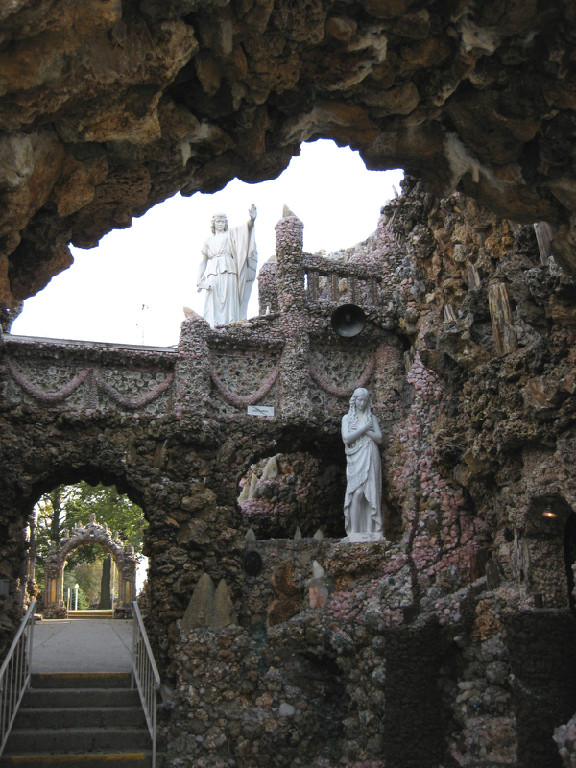
Passing the Torch
Father Dobberstein was seventy-four years old when Father Greving was sent to West Bend to assume Dobberstein’s clerical duties, as well as to assist with the ongoing building project. New to the rigors of grotto construction, Father Greving immediately envisioned the usefulness of an electric hoist and miraculously convinced his superior to introduce this device. Up to that time, all lifting had been done by hand. Dobberstein worked with Father Greving and Matt Szerensce on the Grotto of the Redemption for another eight years.
Rev. Paul Dobberstein, the creator and builder of the famous Grottos at West Bend, Iowa laid down his trowel on July 24, 1954, at 7:25 p. m. It was as if God waited until the last ruddy rays of the setting sun had shed the last warm friendly rays over the twinkling towers of his Grottos and then called the tired artist home from his life’s work. Father Dobberstein was laid to rest in the parish cemetery one-half mile west of the Grotto. The grave marker reads “Father P. M. Dobberstein, 1872-1954.” After forty-two years as a priest, spelunker, and grotto builder extraordinaire, Father Dobberstein passed the torch to Szerensce and Greving. Though he fully believed in the radiating spiritual power of his work, he may never have imagined the magnitude of his influence.
Matt Szerensce continued to work on the Grotto until his retirement in 1959. Father Dobberstein often told Father Greving “the show must go on.” For 50 years Father Louis Greving continued to build and care for the Grotto with the tender hands of a loving Father. Father Greving is quoted in the book “An Explanation of the Grotto of the Redemption,” saying “By providence of God I spent my priesthood of some 45 years (since 1946) in the shadow of the Grotto of the Redemption. The Grotto is a monument of faith, hope and love that once lived in the mind and heart of Father Paul Dobberstein.”
Over some 42 years, he labored laboriously and perseveringly to give the external expression of that faith and love in a structure which is now the Grotto of the Redemption-an artistic portrayal of the life of Christ in stone. Some 100,000 tourists come to see the Grotto annually. As Father Dobberstein’s successor, Father Greving considered it a privilege to carry out his plan the best he could. Spending all except one year of his priesthood at the Grotto, Father Greving continued to build and care for this wonderful gift. But most of all, he welcomed thousands of visitors each year.
Father Greving celebrated 50 years as a priest in 1996. Having retired he continued an active life ministering to and caring for the many who came to know and love him. Fr. Greving departed this life and went to his heavenly reward Feb. 14, 2002. He is buried at West Bend Cemetery.
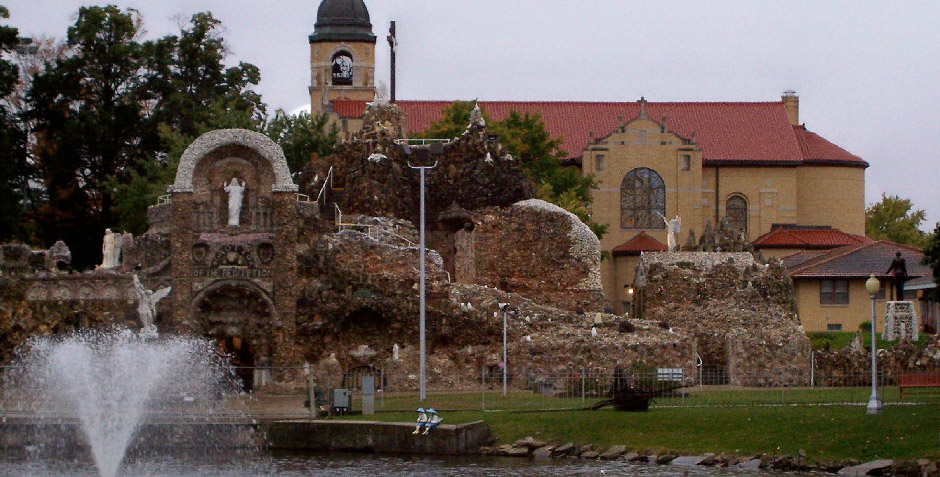
Shrine of the Grotto

© 2024 The Shrine of the Grotto of the Redemption | West Bend, Iowa. Website Development by Neapolitan Labs

